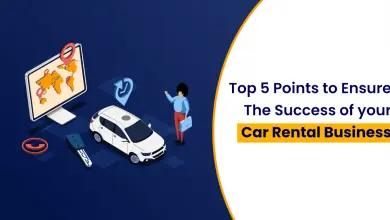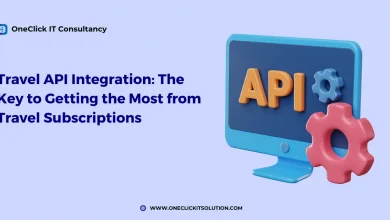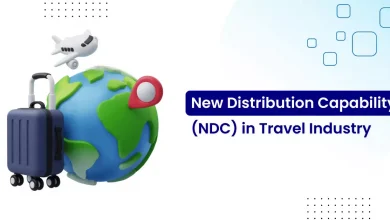Buy Now Pay Later for a Travel Business: How BNPL Works and Ways to Implement It
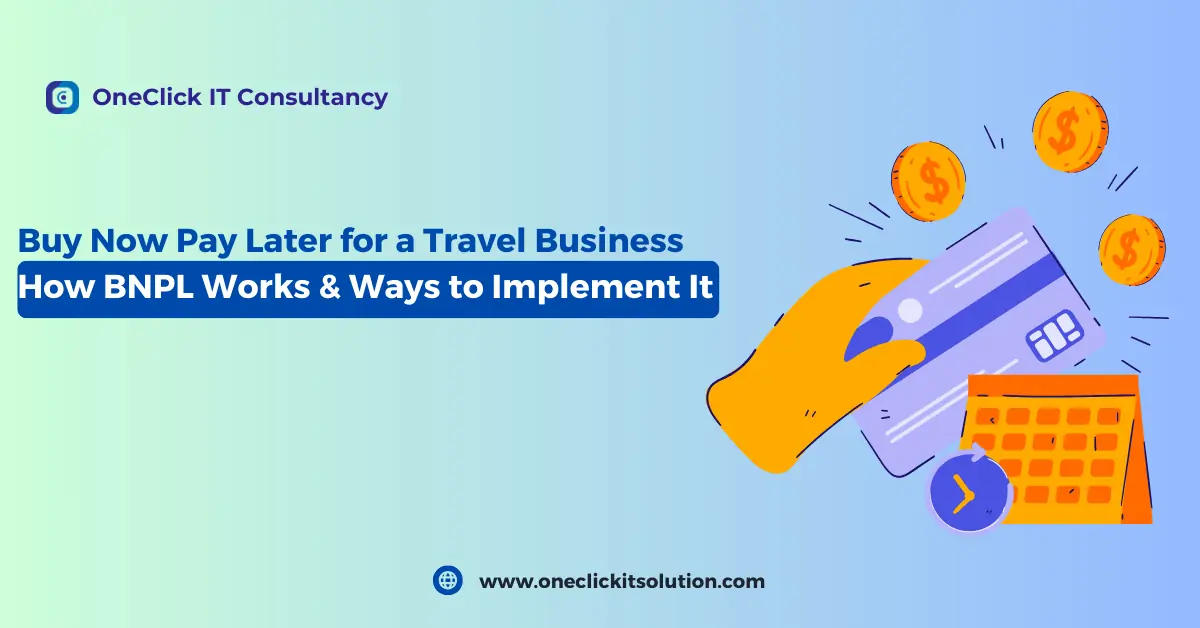
These days, a lot of people are using the “Buy Now, Pay Later” programs to make purchases. A research study done in 2022 calculated that there are around 360 million users of these programs currently. And get this, by 2027, that number is expected to reach a whopping 900 million users! Another survey found that 60% of online shoppers have already tried out these “Buy Now, Pay Later” services. Crazy, right?
All these stats clearly show that consumers are getting really interested in finding alternatives to credit cards for making payments. Originally, these delayed payment options were mostly used for big purchases like furniture, electronics, or vacations. But now, it’s becoming so common that even apps are offering to let you pay for snacks in 4 installments over 6 weeks! Isn’t that crazy?
It’s pretty obvious that businesses need to catch up with these trends and give their customers the payment options they want. In this article, we’ll discuss how the “Buy Now, Pay Later” approach is being used in the travel industry. We’ll also talk about the main providers of these services, and look at how businesses can implement it and benefit from offering delayed payment plans.
What’s this “Buy Now, Pay Later” all About?
Don’t be confused by the fancy name – BNPL is not exactly a revolutionary concept. However, BNPL definitely brings back the tried-and-true method of spreading out payments, but with a digital twist.
So, what is BNPL? At its core, BNPL is a financial service that allows consumers to make purchases immediately and defer payment into smaller, more manageable installments. The concept boils down to making credit simpler by offering “instant credit” right when you’re making a purchase.
So, when you buy something online (or even in a store as the trend catches on), you can choose to pay in installments without dealing with all the fees and complications of a standard credit card.
It is basically a type of short-term loan that lets you split up the cost of your purchase into multiple smaller payments. Usually, you gotta make the first payment at checkout, and then you pay off the rest weekly, every two weeks, or monthly. This flexibility makes it particularly attractive for larger purchases.
How It Works: Payment Structure
The process begins with a small upfront payment at the time of purchase, ensuring that consumers can secure their goods or services immediately. Subsequently, the remainder of the cost is divided into scheduled payments. These can be weekly, bi-weekly, or monthly, providing a customizable approach to managing expenses.
- The “Pay-in-Four” Model: This is a common setup that involves 4 payments spread out over 6 weeks, although this can vary depending on the provider and the purchase amount. Since BNPL is pretty much a loan, they’ll do a little credit check on you, but it’s just a soft one.
For retail purchases, you get your stuff right after that first installment. But for services like travel, insurance, education and such, you generally have to pay it all off before you can actually use the service. A good example is booking a vacation or flight way in advance – you’ll have to make all the BNPL payments before your departure date.
BNPL Benefits
Let’s understand why “buy now, pay later” is awesome for everyone involved – customers, shops, and even the companies giving out the loans.
For shoppers, BNPL makes life easier because:
- Buy expensive stuff: They can buy costlier products without dropping all their cash at once.
- Lock in the best deal: They get to lock in the best price for something, even if you’re not paying for it all upfront.
- No credit card hassle: No need to stress about those pesky credit checks or getting hit with interest fees on your credit card.
- Spreads out the payments: It helps them manage their money better by spreading out your payments.
- Covers unexpected expenses: They can snag that must-have item before it disappears from the shelves. Plus, it’s handy for unexpected expenses that pop up out of nowhere.
Now, for businesses, having BNPL as a payment option is a customer magnet:
- More customers = more sales! It brings in more customers who might not have been able to afford big purchases otherwise.
- Bigger purchases, bigger profits: People tend to buy more stuff when they know they can pay for it in chunks later on. It’s like a little nudge to treat yourself a bit extra.
- Perfect for big-ticket items: Businesses selling pricier items, like travel stuff, can really benefit from BNPL since it helps customers say yes to those dream vacations or fancy trips they’ve been eyeing.

Implementing BNPL in Your Travel Business
Alright, so you want to give your customers that sweet BNPL payment option on your booking website? There are a few key steps to make that happen.
Step 1: Choose a BNPL Provider
- Picking Your BNPL Partner: First up, you gotta choose who you wanna work with. There’s a whole bunch of BNPL providers out there, each with their own style. Some are big and cover lots of different stuff, like Klarna or Affirm, and some are more like specialists, focusing on just travel stuff, like Fly Now Pay Later.
- Understanding the Commission Game: Now, you gotta figure out how they want to be paid. Some BNPL services say, “Hey, you give us a little bit from each sale,” which is usually about 3-6% plus maybe a tiny extra fee for each transaction. This way, your customers don’t pay extra, and they like that. The other way is where your customer pays interest over time, but you don’t pay anything to the BNPL provider. It’s less common because, well, people don’t like extra costs.
- Calculating the Costs and Wins: Take a minute to crunch some numbers and see what makes sense for you. Will the extra sales be worth the commission you pay?
- Making the Tech Work: If you’re going to add BNPL, it should work smoothly with your payment system. Lots of BNPL providers are already collaborating with big eCommerce platforms and payment processors. So if you’re using something like Stripe, you’ll want a BNPL partner that plays nice with it, making your life way easier.
- Keeping Things Safe: Last but not least, you want to make sure everything is safe and secure.. Most BNPL providers have got their shields up against fraud, but you’ll want to go with one that’s got a good rep and solid security measures. And don’t forget to keep your own systems safe in the process!
Step 2: Choose a Partnership Model
When it comes to partnering with a BNPL provider, there are two main models businesses can choose from:
1. Merchant-Partner Model:
This is the more common option. It means adding the BNPL payment option to your website’s checkout. If you already have a way for people to book and pay online, this is where we’d fit in. Most BNPL lenders also provide online portals to handle any payments you receive offline as well.
The downside? Well, you’ll need to tweak your checkout process to add this new payment option. Depending on your tech setup and the provider you choose, this might take some work.
2. BNPL App Model
With this model, the BNPL lender essentially adds your products/services into their proprietary shopping app that consumers can access. There are two ways this can work:
- Redirect: The BNPL app shows your travel deals, but when a customer wants to book, they get sent to your website to complete the purchase.
- In-App Booking: Some BNPL apps let customers book directly within the app. This requires a deeper integration with the provider, where they pull your travel info (availability, pricing) right into their app.
Which Model is Best for You?
Many major BNPL players offer both partnership models. ravelers tend to look for trips deliberately, not just stumble across them while browsing for boots or blenders.
So, for a travel business specifically, the merchant-partner integration is likely preferable. But you could potentially do both if it makes sense.
Step 3: Applying for Partnership
Once you’ve identified the BNPL provider(s) you want to partner with, you’ll need to submit an application with basic details about your company. Just like consumers go through vetting, merchants also have to meet certain qualification requirements set by the lender. This is because all financial institutions must adhere to KYC/AML regulations.
However, the travel industry is generally eligible for BNPL partnerships, unlike restricted industries like tobacco, gambling, weapons, etc. So you likely won’t face major hurdles in getting approved as long as you meet the provider’s basic criteria.
Step 4: Integration Process
The complexity of integrating the BNPL functionality will depend on the partnership model you choose (merchant vs app) and whether the lender has pre-built integrations with your existing payment technology stack.
For the more common merchant-partner model where you integrate BNPL into your own checkout, you’ll likely need to build the integration from scratch if it’s not pre-integrated. This will require engaging IT resources to properly develop against the provider’s APIs.
But don’t stress too much. All BNPL providers want to make things easy for you. They all have tools (like open APIs) to help connect to your payment system. And if you decide to show your travel stuff in their app, they’ll even do the integration for you.
Current Challenges with Buy Now, Pay Later (BNPL) for OTAs
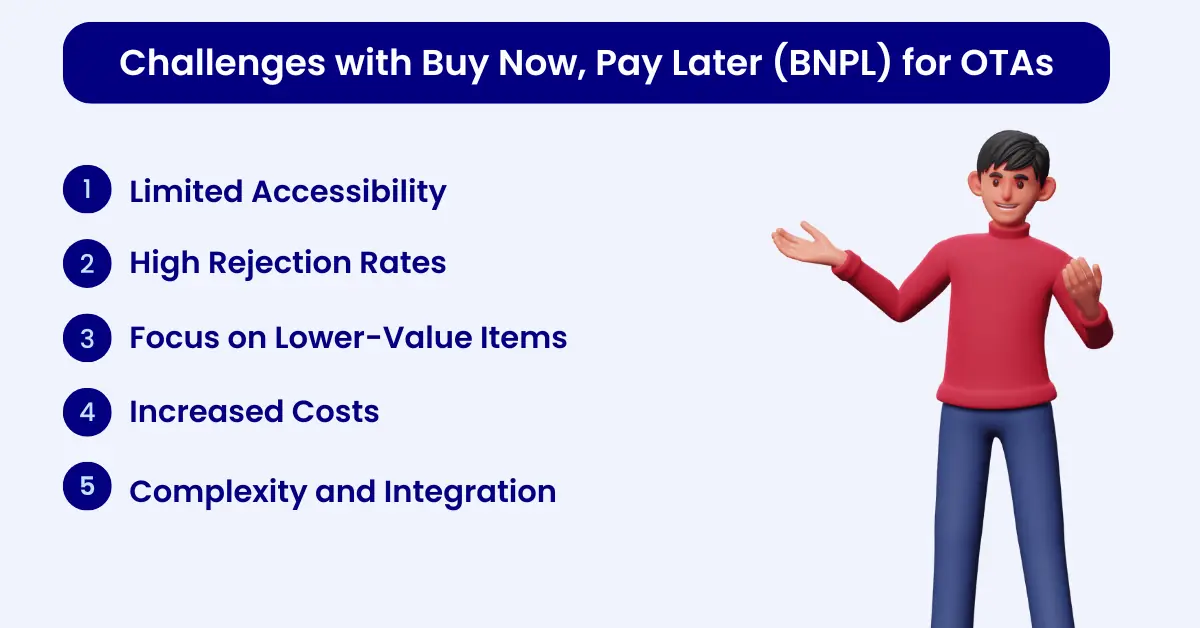
We know for sure now that BNPL is great in theory and has potential for both travel agencies and customers. But there are a few bumps that need to be ironed out before it becomes a smooth experience for everyone.
1. Limited Accessibility: For starters, a lot of these BNPL deals are really only meant for customers with stellar credit scores. They call this “prime lending.” But that locks out a huge chunk of shoppers who could really benefit from the flexibility of paying over time. So for OTAs and travel merchants, you’re automatically turning away potential customers right off the bat if you only partner with BNPL providers doing prime lending. That’s lost business!
2. High Rejection Rates: the decline rates for BNPL approval can be crazy high, like up to 70% in some cases. That means a ton of shoppers are getting rejected and having a crummy payment experience at checkout. The main reason for these high rejection rates? You guessed it – most BNPL companies today still only do that prime, ultra-strict lending.
3. Focus on Lower-Value Items: Now, offering financing at checkout is supposed to open up more revenue for travel merchants by letting more people book and spend more overall. But the current BNPL services mostly target lower-cost purchases. There’s a missed opportunity for bigger ticket items where BNPL could really help people manage cash flow better.
4. Increased Costs: We can’t forget – BNPL ain’t cheap for merchants! You’re looking at an extra 3-7% on top of regular credit card fees. Yes, you get paid upfront while the BNPL provider chases down payments later. But those extra costs can really eat into tight margins.
5. Complexity and Integration: having a bunch of different BNPL options at checkout runs the risk of cluttering and confusing the heck out of shoppers until they abandon their cart entirely. Not ideal! Plus, integrating all those separate BNPL payment methods is an operational nightmare – pricey, time-consuming, and pulls resources away from more important projects.
Now, even though BNPL has its challenges, we can’t ignore the promising benefits it offers to OTAs and travel businesses. It allows customers to manage their finances according to their preferences. The smart move may be working with payment partners that can help your OTA set up the right mix of BNPL solutions fitting your particular customer base and business needs.
Debt Traps: The Catch with Buy Now, Pay Later for OTAs
- Let’s go back to the Pandemic era once to understand this. Can you recall how rough were with all those restrictions and economic troubles? And it was especially tough for people and small businesses who were strapped for cash. That’s where BNPL provided by fintech lenders became useful – it gave customers a way to pay over time without jumping through all the hoops of a traditional bank loan. The process was much more streamlined through these BNPL platforms.
- Now, these fintech companies that offer BNPL are different from traditional banks. They’ve made the process way simpler and smoother for getting loans without all the usual headaches. But here’s the catch – travel businesses that want to offer BNPL can’t just ignore the potential risks for themselves and their customers.
- They need to get their ducks in a row – have solid underwriting processes to assess who qualifies for BNPL financing and a clear plan for recovering payments if people default. And they’ve got to work on teaching their customers good financial habits, so people don’t just keep racking up debt they can’t afford.
- Now one tricky issue travel merchants must watch out for is this thing called “loan stacking.” Basically, when people take out multiple BNPL loans rapidly, like within 36-48 hours, from various lenders. Those can all get approved without the lenders realizing the total debt load is more than that customer can reasonably handle. As BNPL is growing more popular, this would lead to more fraud and people just digging themselves into a never-ending debt hole.
- So, OTAs will have to be mindful of managing these kinds of risks. They will have to find that sweet spot between making it convenient for customers to pay over time while also protecting everyone involved from potentially messy situations.
- Big companies in the travel industry, like ARC, Sabre and Amadeus, are working with “buy now, pay later” providers like Uplift and Fly Now Pay Later. This means travel agencies and airlines can offer these payment plans to their customers. Let’s break it down real quick:
- First up, we’ve got ARC Pay – this allows travel agencies to process payments and they’ve partnered with Uplift to provide BNPL. If you’re an ARC-accredited agency or Verified Travel Consultant, you’ll need to register with Uplift, take their certification course, and then you can offer BNPL bookings through the ARC Pay Hub.
- Next, we’ve got Sabre’s Digital Connect API. This connects travel partners to Sabre’s tech including payment management. They’ve got this “Book Now, Pay Later” option backed by BNPL lender Zip. Airlines can incorporate this into their ticketing process so flyers can put bookings on hold using BNPL.
- Lastly, there’s Amadeus’ Xchange Payment Platform run by their subsidiary Outpayce. They work with banks, payment providers, fraud prevention services – the whole nine yards for smooth travel payments. Just recently, they announced partnerships with Uplift and Fly Now Pay Later to allow travel merchants like airlines and hotels to easily add BNPL options across their sales channels.
- So, basically, these travel giants have realized BNPL is a must-have for travel these days. They are making it easier for your customers to book their dream vacation and spread out the payments. If you’re an OTA or travel business, it may be worth looking into collaborating with these major players to integrate BNPL seamlessly into your payment flow.

Fraud Risks with Buy Now, Pay Later for Travel Industry
By now, we must be on the same page that Buy Now, Pay Later (BNPL) schemes have the potential to revolutionize the travel industry for both agencies and their clients. However, BNPL opens up the possibility of some unique fraud risks that travel businesses can’t ignore.
The BNPL Structure Attracts Fraudsters
The whole concept of BNPL – splitting payments over time – creates what experts call an “expanded attack surface” for fraudulent activities. It makes these platforms a juicier target compared to traditional lenders.
Think about it – fraudsters have more opportunities to exploit the system with multiple payment touchpoints instead of just one full payment upfront. BNPL providers face a higher risk of synthetic identity fraud, account takeovers, and chargeback fraud. Let’s understand a few more things:
1. The Quick Pace of BNPL Decisions: One of the first things to understand is that BNPL decisions happen at lightning speed, which makes it a double-edged sword. Unlike traditional credit assessments that could take days, BNPL verdicts are made in just a few seconds. On one hand, it’s fantastic for quick bookings, making everyone’s life easier. But, on the flip side, it also leaves the door wide open for fraudsters using fake or stolen identities. Traditional lending takes its time, checking IDs at the door, while BNPL’s quick draw on approvals makes it a hot target for identity thieves. That’s a risky business!
2. The Burden of Chargeback Fraud: Here’s where things get a bit more complicated for travel businesses. Many BNPL providers take the chargeback risk off the merchants’ shoulders. While this might sound like a dream, making your travel offerings more attractive, it also means BNPL services are a magnet for fraud. Imagine a fraudster booking a lavish holiday, and when the payment bounces back as fraudulent, the BNPL provider is left holding the bag. It’s an added incentive for crooks to target your business, knowing they won’t face the music for chargebacks.
3. Fraud Types that Hit Close to Home: It’s not uncommon for fraudsters to parade around with stolen identities or seizing control of legit accounts. As a travel business, you must keep an eye out. Here are three types of BNPL fraud to watch out for:
- Identity theft: Here, fraudsters use stolen identities of good customers to open new BNPL accounts and book trips under someone else’s name.
- Account takeover: This is even sneakier, with crooks hijacking a customer’s established account and maxing out the credit.
- First-Party Fraud: This is the classic fraud, where a legitimate customer makes a purchase via BNPL with no intention of making payments
But, how do BNPL companies quantify these risks?
Well, here’s a thing – Quantifying these risks is tricky business. The first step is distinguishing BNPL fraud risks from general credit risks:
- Credit Risk: Customer genuinely wants to pay but circumstances like job loss make repayment difficult
- Fraud Risk: Customer uses stolen identities/cards with zero intention to repay – resulting in chargebacks and defaults
BNPL companies can try to recover losses from credit risks by adjusting repayment plans. But fraud losses are virtually unrecoverable since the perpetrators are long gone.
Preventing Strategies For BNPL Frauds
1. Solid Check-in Process:
Just like checking in a guest, verifying a customer’s identity during the BNPL process is crucial. It’s not just about making sure they are who they say they are but ensuring they’re the type of customer who doesn’t leave without settling the bill. This first step in the customer’s journey can deter many fraudsters looking for an easier target.
2. User Authentication:
Before letting a customer book a BNPL trip, make sure they really are who they claim to be. However, despite robust check-ins, some desperate fraudsters will still slip through. Here’s where you need to tighten security. You can block them by authenticating the user before allowing BNPL purchases with multi-factor authentication, biometrics, etc.
3. Activity Monitoring:
BNPL is convenient but opens a new can of worms for travel fraud. Once a booking is made, don’t just wait for the no-show or cancellation. Since BNPL having minimal transactions, you must also keep close tabs on other user activities like account logins, devices, IP addresses for suspicious patterns indicating potential misuse. Unusual login patterns or booking behaviors can be the smoke signal you need to prevent a fire.
Ultimately, the more information you have, the better. Back in the day, fraud detection used to focus only on individual transactions. But now, organizations have a lot more indicators to work with. Just analyzing transactions won’t cut it when it comes to spotting BNPL fraud. Risk and compliance teams need to be able to consider a wider range of factors when checking out monitoring solutions.


